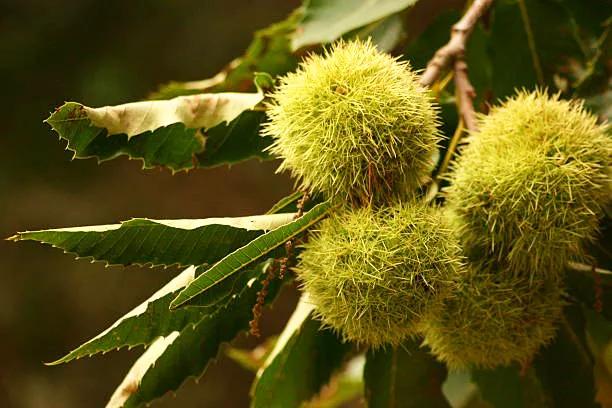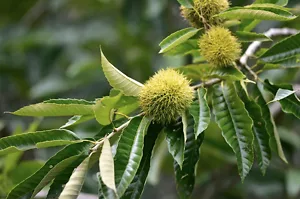
Written by s • Welcome Back to the American Chestnut
We hear a lot today about the loss of species, and mass extinctions. Yet less than a hundred years ago there was a mass extinction on a huge scale right here in North America, which has largely been forgotten and has passed into history. This was the near-extinction of the American chestnut, a magnificent and useful tree once found throughout all the forests of the eastern states. It is estimated that between 3 and 4 billion trees perished in the first half of the 20th century. It such a thing were to happen today there would be a huge outcry, but this extinction seemed to pass with just a little regret.
The Story of the American Chestnut
The American chestnut (Castanea dentata) had always been an important part of the ecosystem of the great forests of the east, mixed with other trees, like oak, maple, hickory and ash. At least a quarter of the trees in those forests were chestnuts. They grew rapidly and produced many nuts, so there were always fast growing seedlings ready to fill any gaps among the trees. As well, the nuts were an important food source, for bears, wild boar, and squirrels, as well as for numerous birds. They were also food for Native Americans and farmers, who used them both as human food and for livestock. Chestnuts were a common food on almost every table, and sold roasted on street corners in many cities. The wood was also widely used for construction of both barns and homes, and the tannin for leather work.
Then in 1904 disaster struck. Some Asian Chestnuts (Castanea mollissima) planted on Long Island developed a fungal disease to which they were largely immune. When this spread to the American chestnut they had no immunity, and vast numbers began to die. Over the next 40 years almost every tree in the country died, except for a few pockets here and there. The stumps of some trees re-sprouted, but they usually became re-infected within a couple of decades and die back once again, Not only did the forests suffer, but the chestnut disappeared from the American table. Since this was during the Great Depression, the loss of this free source of food only increased the hardship of rural people.
The Return of the American Chestnut
It seemed that all was lost, but it wasn’t. In the 1950s a nut enthusiast called James Carpentar, who came from Salem, Ohio, found a large, still-living tree in an area filled with dead trees. Realizing that it could have immunity to the deadly fungus, he even tried to infect it – but the tree remained healthy. He sent some branches to a fellow enthusiast and plant breeder, Dr. Robert T. Dunstan, and to preserve the genetics of the tree he grafted it onto chestnut roots and found the trees grew well. He knew that to strengthen the resistance of the tree he needed to bring in some of the protective genes that the Asian chestnut had, so he cross-pollinated James Carpentar’s trees with some top-quality Asian varieties he had. Over the next 30 years, Dr. Dunstan crossed and re-crossed his trees, always with the healthiest ones, and those with the best and sweetest nuts. Eventually he had a strain of trees that combined American and Asian characteristics and that has now lived for 50 years without showing sign of the disease. These trees became known as the Dunstan chestnut.
Now It’s Your Turn
The Dunstan chestnut is now available to everyone. If you have eaten chestnuts you already know how good they are, and how versatile. Chestnuts can be roasted over an open fire and eaten right out of the shell. They can be boiled briefly to help remove the shell, and then cooked in casseroles, stews, or braised in the oven. They are also used in sweet dishes, and they can be ground into flour and added to cakes and bread to enrich them with flavor and protein. Unlike other nuts, with their high fat content, chestnut have only 2 or 3% fat, so they are incredibly healthy.
The Dunstan chestnut is a fast growing tree that is easy to grow across most of the country. It grows well in a wide range of soils, and once established it is drought resistant too. Most importantly, after decades of healthy growth, it seems to be immune to the terrible blight disease. Unlike other kinds of nuts, these trees carry a heavy crop every fall, and begin to bear within a few years of planting. They need no chemical fertilizers or sprays, so they are naturally an organic food too. It is necessary to plant at least two trees for cross-pollination, but the good news is that both trees will bear nuts, so you double your harvest. You don’t even need to climb the trees – just wait for the nuts to fall and then pick them off the ground. Their green, spiny case breaks open to reveal inside several large shiny nuts. Unlike other wild chestnuts, the Dunstan chestnut is naturally sweet and makes great eating
Planting Season Has Arrived
The market for chestnuts is booming, and prices are high. For a low investment in trees, you can plant a grove and soon be harvesting a crop that is in high demand. A grove of trees should have the trees planted 20 to 40 feet apart, to allow for good growth and give the maximum yield per acre. This is a viable business proposition for anyone with some land to spare. Even if you only have room for two trees, you can look forward to a bumper crop of your very own chestnuts just a few years after planting trees that basically take care of themselves. What’s not to like?






